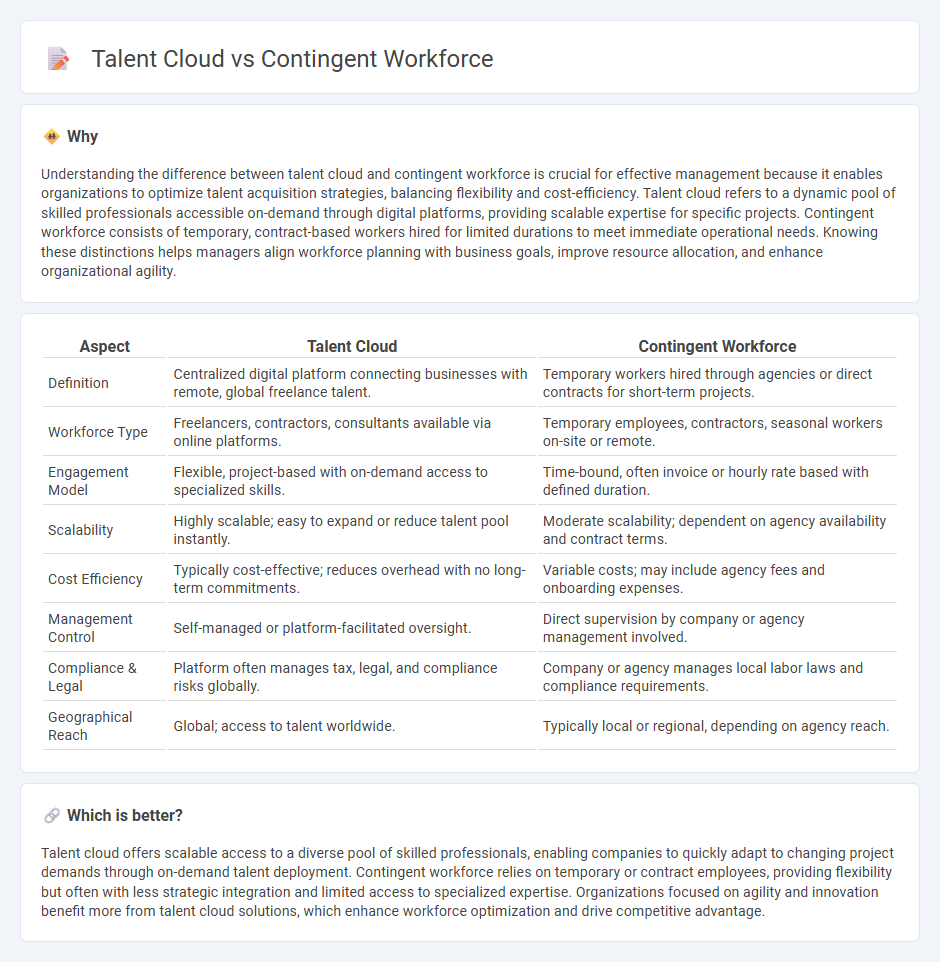
Talent clouds provide businesses with scalable access to highly skilled professionals on-demand, leveraging digital platforms for seamless talent sourcing and management. In contrast, contingent workforce solutions focus primarily on temporary staffing and contract labor to address short-term project needs and operational flexibility. Explore how integrating these models can optimize workforce strategies for innovation and efficiency.
Why it is important
Understanding the difference between talent cloud and contingent workforce is crucial for effective management because it enables organizations to optimize talent acquisition strategies, balancing flexibility and cost-efficiency. Talent cloud refers to a dynamic pool of skilled professionals accessible on-demand through digital platforms, providing scalable expertise for specific projects. Contingent workforce consists of temporary, contract-based workers hired for limited durations to meet immediate operational needs. Knowing these distinctions helps managers align workforce planning with business goals, improve resource allocation, and enhance organizational agility.
Comparison Table
| Aspect | Talent Cloud | Contingent Workforce |
|---|---|---|
| Definition | Centralized digital platform connecting businesses with remote, global freelance talent. | Temporary workers hired through agencies or direct contracts for short-term projects. |
| Workforce Type | Freelancers, contractors, consultants available via online platforms. | Temporary employees, contractors, seasonal workers on-site or remote. |
| Engagement Model | Flexible, project-based with on-demand access to specialized skills. | Time-bound, often invoice or hourly rate based with defined duration. |
| Scalability | Highly scalable; easy to expand or reduce talent pool instantly. | Moderate scalability; dependent on agency availability and contract terms. |
| Cost Efficiency | Typically cost-effective; reduces overhead with no long-term commitments. | Variable costs; may include agency fees and onboarding expenses. |
| Management Control | Self-managed or platform-facilitated oversight. | Direct supervision by company or agency management involved. |
| Compliance & Legal | Platform often manages tax, legal, and compliance risks globally. | Company or agency manages local labor laws and compliance requirements. |
| Geographical Reach | Global; access to talent worldwide. | Typically local or regional, depending on agency reach. |
Which is better?
Talent cloud offers scalable access to a diverse pool of skilled professionals, enabling companies to quickly adapt to changing project demands through on-demand talent deployment. Contingent workforce relies on temporary or contract employees, providing flexibility but often with less strategic integration and limited access to specialized expertise. Organizations focused on agility and innovation benefit more from talent cloud solutions, which enhance workforce optimization and drive competitive advantage.
Connection
Talent cloud platforms enable organizations to seamlessly access and manage their contingent workforce by leveraging advanced digital tools and centralized talent pools. These platforms optimize workforce agility, reduce hiring cycles, and improve resource allocation by integrating freelance, contract, and temporary workers into a unified system. Contingent workforce management via talent clouds enhances real-time visibility, compliance tracking, and cost-efficiency for dynamic project needs.
Key Terms
Flexibility
The contingent workforce offers businesses on-demand labor with flexibility in hiring temporary or project-based talent, enabling rapid scaling without long-term commitments. Talent clouds provide a digital platform connecting organizations to a global pool of skilled professionals, enhancing flexibility through real-time access and seamless talent management. Explore the advantages of these strategies to optimize workforce agility and meet evolving business needs.
On-demand staffing
On-demand staffing leverages both contingent workforce and talent cloud models to provide flexible, scalable labor solutions tailored to real-time business needs. Contingent workforce includes temporary workers engaged through agencies, while talent cloud platforms offer direct access to a distributed pool of freelance professionals with specialized skills. Explore the advantages and nuances of on-demand staffing to optimize workforce agility and reduce operational costs.
Technology platforms
Technology platforms for contingent workforce management prioritize streamlined onboarding, time tracking, and compliance automation through specialized software solutions. Talent cloud platforms leverage AI-driven talent pools, real-time collaboration tools, and analytics to optimize workforce agility and skill matching. Explore the evolving technologies shaping workforce management for a deeper understanding.
Source and External Links
What Is a Contingent Workforce? - A contingent workforce consists of contractors, consultants, freelancers, and temporary workers engaged under contract for specific projects or periods, providing organizations with flexibility and access to specialized skills as needed.
Contingent workforce program strategies - Contingent workers enable companies to quickly fill skill gaps, scale workforce size with demand, and reduce costs, though managing them also involves balancing potential risks.
Contingent Worker - Using contingent staff allows businesses to rapidly access skilled talent, improve productivity through project-based pay, and maintain operations during hiring shortages or market fluctuations.
 dowidth.com
dowidth.com